MIG welding is one of the most straightforward welding techniques that found its way into various applications, but as good as it sounded, there were certain limitations.
That’s why inventors worked on a welding process that is based on MIG welding but carries the good sides of Stick welding.
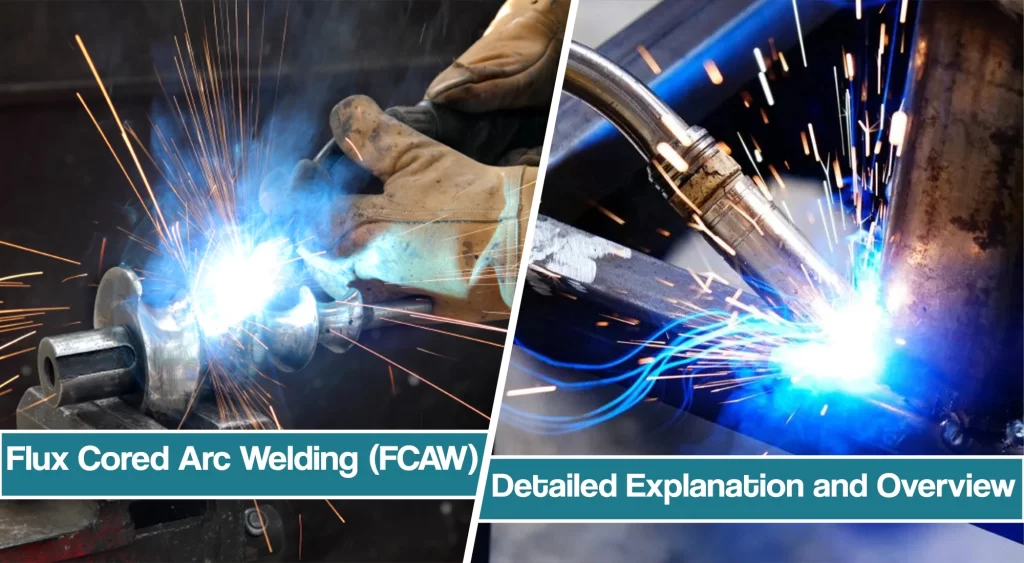
Years of practice resulted in the Flux core welding (FCAW) method, which is just like MIG welding but uses a self-shielded wire based on stick electrodes. Therefore, the new method, flux-cored arc welding, combined the ease of use of MIG welding with the overall productivity and versatility of Stick welding.
Let’s see what flux core arc welding is, how it works, and what are its advantages and drawbacks.
What is Flux Core Welding?
Flux core is an arc welding process that uses heat generated by welding arc to fuse metals. A specific, self-shielded, or flux-cored wire is continuously fed into the weld area. As the filler metal melts, it fuses the two pieces, granting an excellent weld strength.
While everything we said reminds us of Gas metal arc welding (MIG welding), there is one significant difference – flux core wire.
This wire is a hollow and tubular flux-cored electrode filled with flux. The flux protects the weld metal from contamination as it forms a protective layer of slag. As a result, with Flux-cored welding, you don’t have to use an external shielding gas like with solid wire.
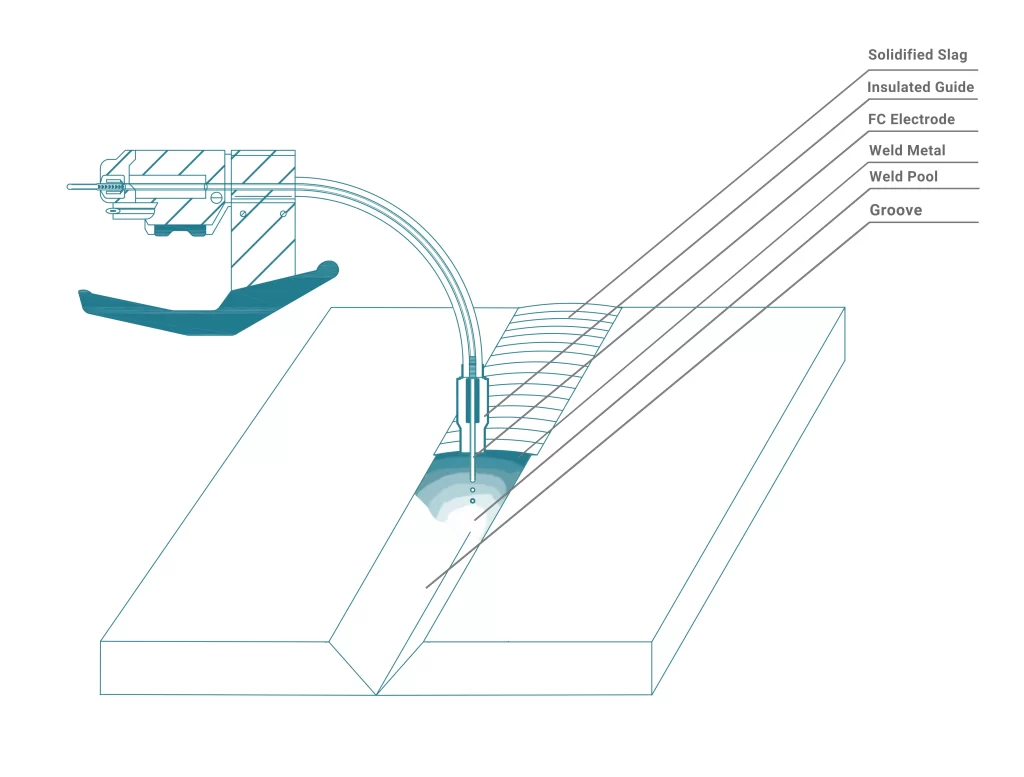
So, as we noted in the intro, Flux-cored arc welding combines the ease of use of MIG welding with the ability to weld outdoors or deal with dirty metal, like with shielded metal arc welding.
Types of Flux Cored Arc Welding
Fundamentally, there are two types of flux core welding: flux cored arc welding (FCAW) and dual shielded flux core welding.
A typical FCAW welding arc process uses a self-shielded wire, and it is the process you probably first thought of when you heard the words flux core arc welding. You have your MIG/Flux core welding machine and flux core wire, so you don’t need an external shielding gas. This process is more than suitable for everyday outdoor work and is highly popular among everyday DIY welders, small shop owners, and welding enthusiasts.
One advantage that makes Flux core welding an industry-suitable welding method is the high deposition rate with good penetration. As a result, you can do your job faster compared to the MIG welding process. However, companies still use stick welding due to the higher prices of flux-cored wires.
Dual-shield FCAW Welding
The welders that require even higher deposition rates and penetration, usually in heavy-duty industrial applications, can choose another option of the FCAW process, the dual shield flux cored welding. In this process, the weld pool is protected by both flux from the dual shield welding wire and shielding gas.
Since people actually use FCAW over the MIG process for the convenience of not having to provide the shielding gas, many wonder why you would opt for dual shielding.
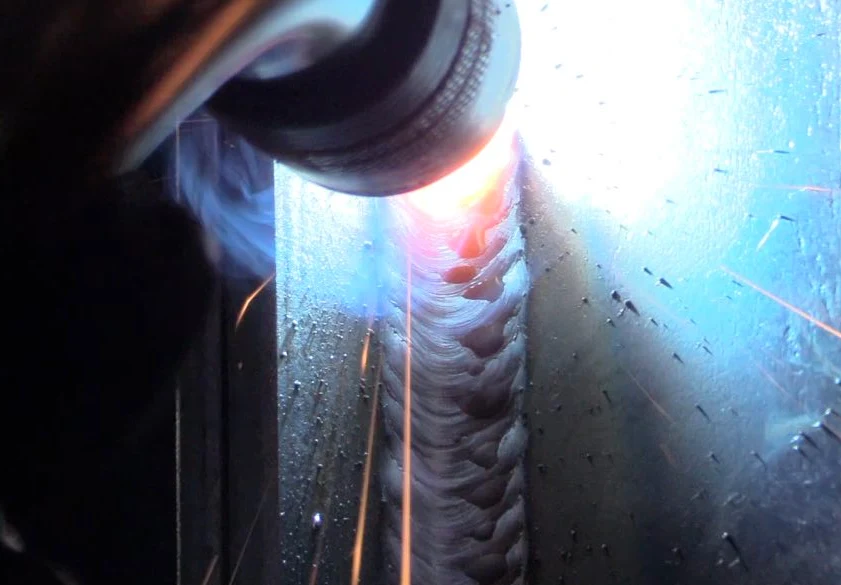
The answer is pretty simple – even higher speeds and penetration. Once you add shielding gas such as carbon dioxide to the already high penetration process, you get an ability to weld significantly thicker materials compared to MIG welding. In addition, welders can use 75% argon and 25% carbon dioxide to get high-quality welds while retaining suitable penetration.
However, this method might not be suitable for welding in draft or wind since it can blow away the shielding. Nonetheless, it is still suitable for heavy-duty applications and when productivity is crucial. You can read more about dual shield welding in our detailed article.
Flux core Welding Equipment
To successfully perform the flux-cored process, you will need suitable equipment. One of the good sides is that equipment requirement is quite low. So all you need is a power source (flux core welder) with a suitable welding torch and filler material.
Flux core Welding Machines
Flux-cored welding machines are quite popular today, as they are commonly part of MIG welders or multi-process machines. In rare cases, you can find dedicated FCAW welders that are usually super-cheap machines, but you lose the ability to run solid MIG wire.
Overall, flux-cored machines utilize direct current that can be either reverse or straight polarity. Self-shielded wires commonly use DCEN, while dual shielded wires can run off DCEP.
When switching between the MIG welder and FCAW process, you will have to reverse the polarity inside or on the front panel of the welder.
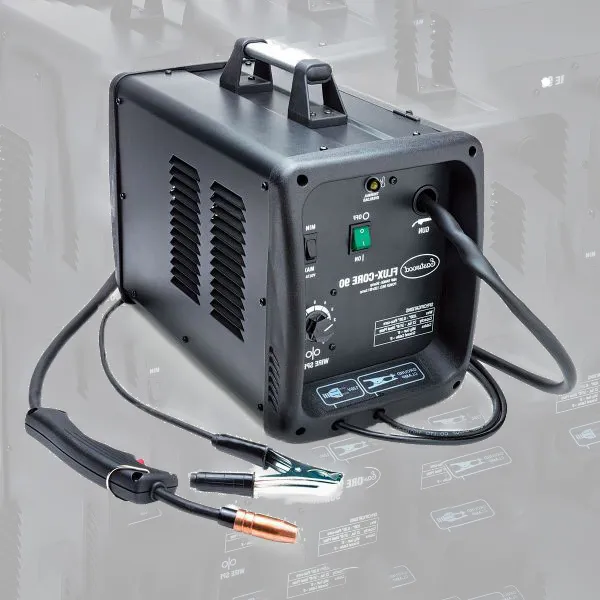
Hobbyist FCAW welders commonly utilize 110V power input, but there are also 230/460V industrial machines. For hobby use, you will be perfectly fine with dual voltage 110/220V. However, if you are looking for a brand-new flux-cored welding machine, feel free to check out the best machines on the market.
As for the power output, most hobbyist flux-cored welders are rated up to 250 amps, and you are perfectly fine with it. However, heavy-duty applications require more power so welders can utilize three-phase high input to output more than 500 amps.
Besides the amperage, you should look for a duty cycle. The duty cycle represents how long the welder can run at a certain amperage before overheating. It is expressed in percentages, and a 60% duty cycle means the welder can run at full power for 6 minutes straight before making a 4-minute break. Keep in mind that some latest inverter flux-cored welders can even
Besides providing a constant power supply, FCAW welders also include several essential pieces for the welding operation. That’s why they come with a welding torch and a wire feed mechanism.
FCAW Welding Gun
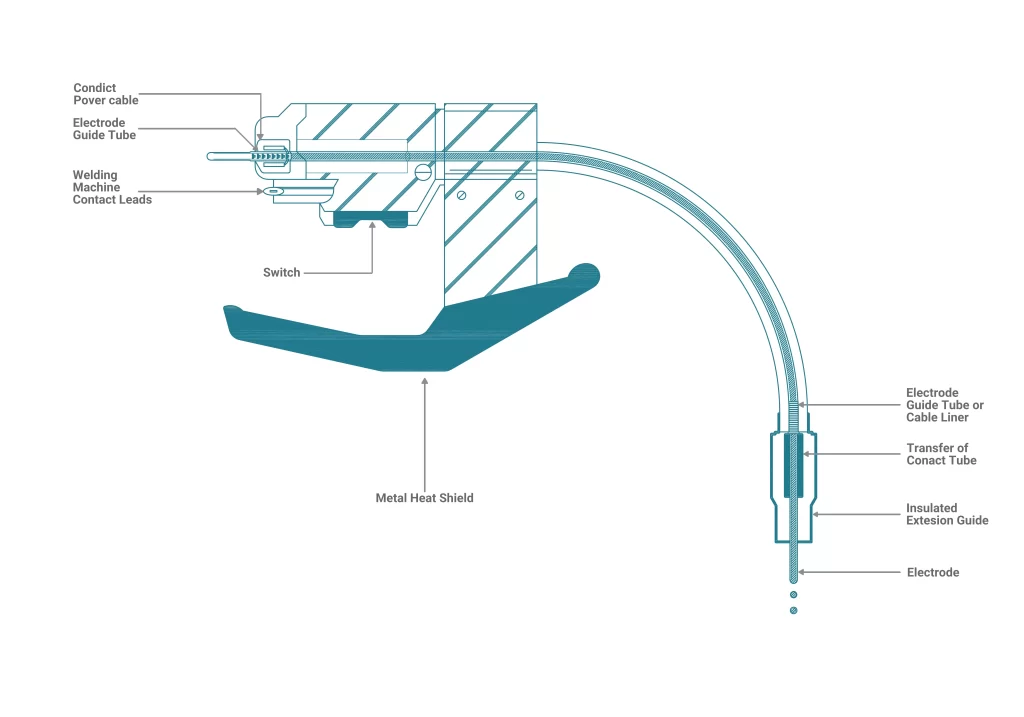
The torch for the flux-cored arc welding can also run solid wire, and they are a standard part of any package and are often referred to as MIG guns.
The manufacturers rate the torch according to the amperage they are capable of withstanding without damaging the components.
In addition, since the welding current generates heat, the torch can have a separate cooling.
An air-cooled torch is usually smaller, and as the name states, it is cooled by the surrounding air and shielding gas. As a result, these torches are suitable for common medium to light-duty applications, as they are rated below 500 amps.
Industrial heavy-grade applications are usually performed at power greater than 500 amps, so they require an adequately cooled torch. That’s when water-cooling is employed, but the torches are bulkier and hard to manipulate.
Before choosing a torch, you should consider your applications and required amperage. However, the bigger is not always, the better, as the higher-rated torches can be bulky and hard to use.
Wire Drive Feeder
The wire drive mechanism in flux-cored welders supplies a continuously fed electrode to the weld puddle. Therefore, the feeder must function well and according to the input wire speed parameters for the best results. The wire feeder consists of drive rolls that guide the wire, a tensioner, a motor, and a liner.
This system usually distinguishes cheap welders from decent machines, as the reliability varies. Cheap welders usually feature plastic feeder, which tends to break down or cause bird nesting and clogs. On the other hand, high-quality welders provide full-metal or aluminum feeders that are durable and reliable. You should check out your feeder if you notice issues with maintaining the arc during welding.
While you can perform the MIG welding technique with common, grooved rollers, flux-cored wire is soft. Therefore, for smooth flux-cored wire feed, you will need knurled rollers. Tensioners will also affect feeding performance; you don’t want the tension to be too high or low.
FCAW Filler Metals
Self-shielded wires are an essential part of the FCAW process, and they are the main thing that deficiencies the MIG from Flux-cored arc welding.
Fundamentally, the core of the fluxed wires is the same as with solid wire, but self-shielded ones are protected by a layer of flux.
So while they apply filler metal to the weld joint, they also protect it by forming a slag coating. Once you are finished welding, you should remove the slag, especially if you are using multi-pass welds, to avoid slag inclusions.
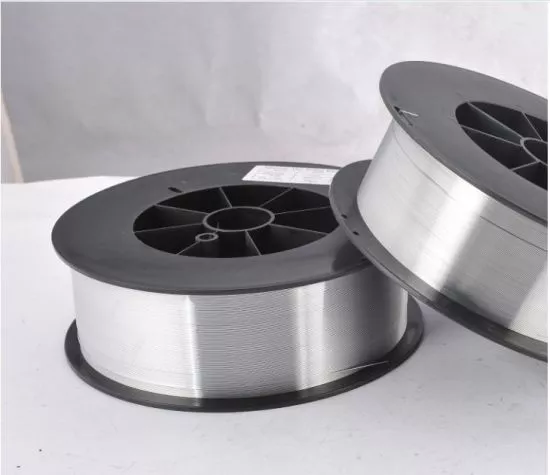
The American welding society (AWS) classifies filler metal into several different categories, such as carbon steel, low-alloy steel, and stainless steel electrodes. The E71T-11 wire can be used in any position, and it is a common all-around choice available in different diameters (0.030-0.045) and suitable for most mild steel. However, since FCAW is not suitable for thinner metals, the wires don’t go below 0.030.
The classification is standard, and in the E71T-11 wire we mentioned above, “E” indicates an electrode; “7” shows the minimum tensile strength in units of 10,000 psi, and “1” indicates the welding positions (all positions). “T” stands for a tubular, and the suffix “11” denotes performance and usability capability.
Flux Cored Arc Welding Technique
After getting familiar with common FCAW welding equipment, it is time for actual welding. Flux-cored welding is as straightforward as the MIG welding process, but there are several precautions and things you should consider before digging in. Let’s see how it is performed.
Weld Preparation
Even though flux-cored arc welding is known for its good performance on dirty or contaminated base metal, you should always clean a welding joint. While cleanliness is not as essential as for TIG welding, you will want to use the wire brush or grinder to clean any rust or mill scale.
When welding significantly thicker materials (over 1/4″), you should bevel the edges for best fusion. In addition, you can use a multi-pass approach, where FCAW can be used for both root and fill passes. However, FCAW is also commonly used in pipeline welding to fill the joint after a TIG root pass. Strength and appearance-wise, the results are similar compared to 7018 stick welding.
Selecting The Filler Metal
Like any other welding process, you should match the filler metal to the welded metal to achieve consistent mechanical properties. Your choice will solely depend on the base metal composition, and the filler metal classification can help you determine your needs.
If you are a hobbyist commonly dealing with mild steel, the E71T-11 electrode wire will do almost all of your work. However, if you weld specific metals, you will have to refer to the AWS A5.20 classification.
In addition, you will need to adjust flux-cored electrode thickness according to the weld metal thickness. As a hobbyist welding thinner materials, 0.030 wire will do the job. As the metal gets thicker, you can switch to 0.035, or in specific heavy-duty applications, even to 0.045 wire.
Adjusting Welding Parameters
Adjusting your FCAW welder can be tricky, as each manufacturer recommends different settings for their machine. Therefore, there is no universal approach, so if you are a complete beginner, you will have to go through a trial and error process.
The chosen voltage and wire feed speed will depend on the wire diameter and material thickness. If you are not sure, you can always check inside the wire compartment or instruction manual for recommendations.
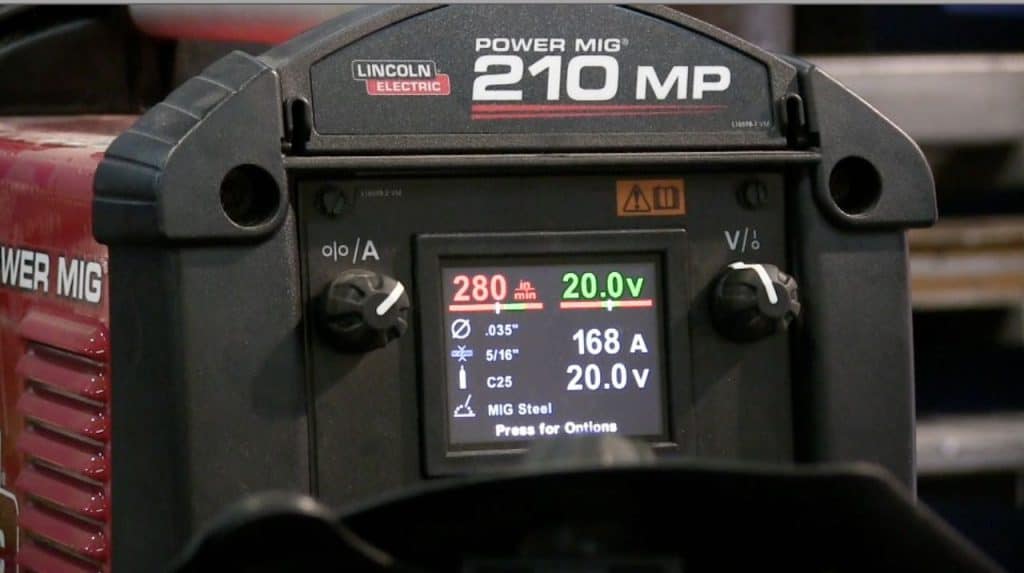
Some welders even include beginner-friendly, smart controls, where you input the metal thickness and wire diameter, and the welder automatically sets the voltage and wire speed. Regardless of the parameters, if you’ve been MIG welding, don’t forget to switch to straight or electrode negative polarity.
In addition, make sure you adjust wire tension and switch the rollers for flux wire. Poor wire feed will result in an unstable arc, and you might have to deal with birdnesting or wire tangling.
Welding Technique
If you are a beginner welder, practicing proper technique can take some time. However, as long as you understand the fundamentals, you will get it right. While there is an everlasting discussion of weither to push or pull in MIG welds, in flux-cored arc welding, you should always drag (pull).
The tip of the welding gun is pointed back at the weld pool and dragged at a travel angle of 5 to 15 degrees. If you increase the travel angle or push in FCAW, you could deal with spatter, less penetration, and an unstable arc.
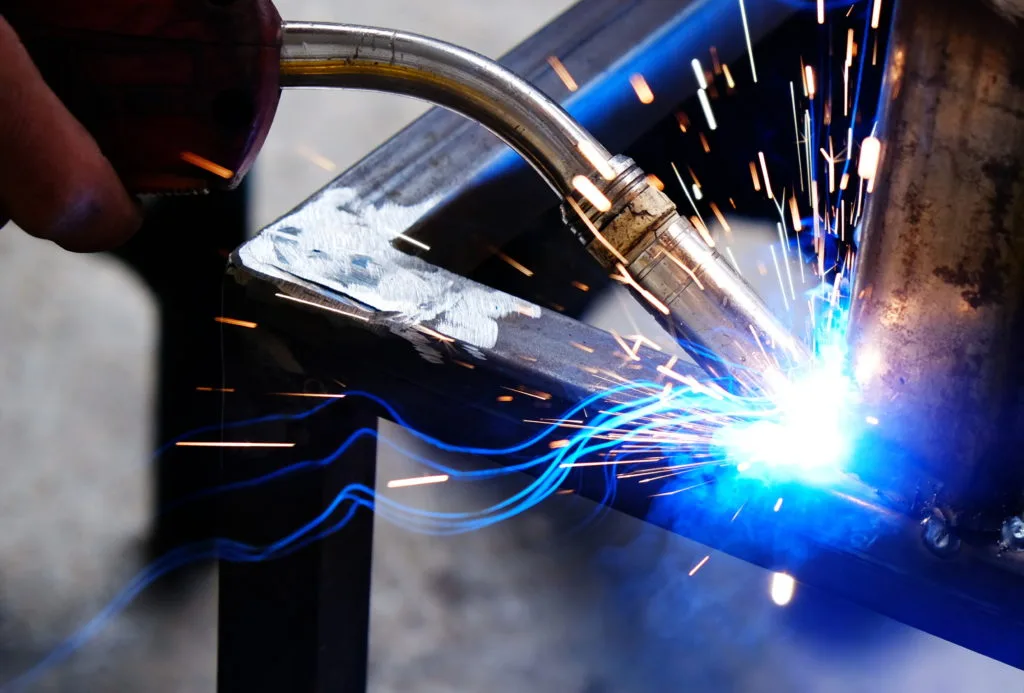
While the travel angle is between 5 and 15 degrees, the work angle can change according to the joint configuration. Butt welds that are performed at 180 degrees will require a 90-degree work angle. In the T-joint configured at 90 degrees, the work angle will change to 45 degrees. Fillet welds will require a work angle of between 60 and 70 degrees.
Besides the work and travel angle, you will have to tweak welding parameters when working in different welding positions:
- Horizontal welding can be performed easily, usually without requiring particular fine-tuning of voltage and wire speed. In specific applications, the travel angle can be lowered to 0-15 degrees while everything else stays the same.
- Vertical welds, both up and down, can be tricky since you are fighting with gravity. To get the best results, you will have to tune down the machine for 10-15% of the recommended settings. V-up is commonly used when welding thicker materials for better penetration, while V-down is more suitable for thinner metals.
- Overhead welding is particularly challenging with FCAW welding, as you are likely to deal with poor results. To try to reduce the voltage and wire feed by 20-25% and keep the travel speed high.
Advantages and Drawbacks of Flux-cored Welding
Like any other welding process out there, FCAW has its ups and downs. While it combined the good sides of multiple welding processes, there are still some drawbacks. So let’s check the advantages and disadvantages of flux-cored arc welding.
Advantages
- Welding outdoors: One of the best parts of FCAW is the ability to use the ease use of wire welding, but also being able to work outside. You don’t have to worry about draft and carry around a cylinder for gas shielding like in GMAW welding.
- High deposition rates: With a proper metal transfer, flux-cored can deposit a significant amount of metal, increasing the overall productivity. Therefore, with FCAW, you can do your job faster.
- Deep weld arc penetration: Flux-cored arc welding produces excellent penetration, and as a result, it is as strong as MIG welding or even stronger. You can employ external shielding gas such as carbon dioxide for even higher penetration for heavy-duty applications.
- Quicker weld preparation: Flux-cored arc welding is more tolerant of dirt and other contaminations on the base metal, so it takes less time to spend on weld preparation.
- High-quality welds: FCAW produces can produce high-quality welds that are strong and nice appearing.
Drawbacks
- Toxic fumes: FCAW produces higher amounts of fumes due to the flux that serves as a shielding gas. Therefore, you should always weld in a well-ventilated area or use a welding respirator in cramped spaces.
- The higher price of flux cored wire: Self-shielded and dual shielded wires are pricier than solid wires and stick electrodes. While the initial price of the wire is higher, the costs can somewhat be compensated by high productivity. We talked more about the price-to-productivity ratio in our flux core wire myths article.
- Flux slag: while FCAW preparation is easier, post-weld slag removal is essential, especially when using multi-pass welding.
- More complex equipment: Flux core welders are more complex and pricier than SMAW machines. Some components, such as MIG guns or wire feeders, can affect the overall results.
- Not suitable for thin metal: The high penetration of FCAW does not mix well with thin metals. While there is a wire that can weld aluminum, the high diameters and penetrations can easily burn-through sheets and other delicate metals.
What is The Difference Between MIG and Flux Core?
While both MIG and Flux cored arc welding are fundamentally similar wire welding processes, the main difference is in the wire choice. MIG utilizes solid wire that requires external shielding gas, while FCAW wires are layered with flux, which replaces shielding gases and protects the weld pool from atmospheric contaminations.
Since there is no need for shielding gas, FCAW can successfully be performed outside, in the wind, or in the draft. However, FCAW wire produces more toxic fumes due to layered flux.
MIG and FCAW can be done using the same power source (Welder), but you will have to switch the polarity prior to welding. While solid MIG wire is cheaper, FCAW produces deeper penetration, and it can easily burn through contamination and dirt in the weld zone.
Resources:
- https://www.twi-global.com/technical-knowledge/faqs/flux-cored-arc-welding-fcaw
- https://www.millerwelds.com/resources/article-library/flux-cored-welding-the-basics-for-mild-steel
- https://www.instructables.com/Basic-Guide-to-Flux-Cored-Arc-MIG-Welding/
- https://www.neit.edu/blog/fcaw-welding
- https://welding.org.au/articles/flux-core-arc-welding/
- https://www.thefabricator.com/thewelder/article/consumables/all-about-gas-shielded-flux-cored-arc-welding-wires





